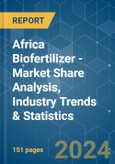The Africa Biofertilizer Market size is estimated at USD 226.59 million in 2024, and is expected to reach USD 354.28 million by 2029, growing at a CAGR of 9.35% during the forecast period (2024-2029).
Key Highlights
- Rhizobium is the Largest Form : Rhizobium is a soil bacteria that aids leguminous plants in nitrogen fixation, potentially replacing commercial N fertilizers. Rhizobium increases agricultural productivity.
- Rhizobium is the Fastest-growing Form : Rhizobium is mostly used for leguminous crops and can enhance output by 25 to 35% while reducing the overall chemical fertilizer requirement by 20 to 25% in some crops.
- Row Crops is the Largest Crop Type : Corn, wheat, rice, and legumes are among the major row crops grown in the region. Rhizobium application dominates the row crop with 45.7% of the market value in 2022.
- Egypt is the Largest Country : Egypt's major crops include rice, wheat, maize, cotton, and fruits and vegetables. Rhizobium is dominant in the country, they accounted for 39.1% of the market value in 2022.
Africa Bio Fertilizers Market Trends
Rhizobium is the largest Form
- Biofertilizers are living microorganisms that improve plant nutrition by mobilizing or increasing nutrient availability in soils. Mycorrhiza, Azospirillum, Azotobacter, Rhizobium, and phosphate-solubilizing bacteria are the most frequent microorganisms used as biofertilizers in agriculture.
- Among these biofertilizers, Rhizobium is most widely used in Africa, accounting for 45.6% of the market in 2022 and valued at USD 87.5 million. Rhizobium is the most prominent nitrogen-fixing bacteria that live in the root nodules of leguminous plants and has a symbiotic relationship with plants.
- Azospirillum accounted for the second-largest market share, valued at USD 43.8 million in 2022. Azospirillum-based biofertilizers promote plant vegetative growth by substituting 25-30% of plant nitrogen requirements.
- Row crops dominated the biofertilizer market, valued at about USD 146.8 million and accounting for 76.5% of the consumption share in 2022, followed by horticultural crops, valued at USD 30.5 million. The market value of biofertilizers in row crops is constantly expanding. It increased by about 17.8% between 2017 and 2021. It is anticipated to increase by about 69.6% by the end of the forecast period, reaching USD 270.0 million.
- The application of biofertilizers can reduce the use of chemical nitrogen fertilizers and the overall cost of cultivation. The demand for organic products in domestic and international markets is increasing, thus driving the demand for biofertilizers in the region.
Egypt is the largest Country
- As the demand for organically cultivated food grows in many African countries such as Egypt, Nigeria, and South Africa, Africa is a significant market for biofertilizers. During the historical period (2017-2022), the region's organically cultivated area expanded slightly, from 1.1 million hectares in 2017 to 1.3 million hectares in 2022. During the same period, the African biofertilizer market grew by 6.9%. Majorly cereal crops are produced in the region, like maize, wheat, and corn.
- Rhizobium is the most often used biofertilizer in African countries, accounting for 45.6% of the market in 2022 and worth USD 87.5 million. Rhizobium is the most prominent nitrogen-fixing bacterium that resides in the root nodules of leguminous plants and has a symbiotic connection with plants.
- In the Rest of Africa, in terms of area, Tunisia was the region's largest organic producer in 2021. Around 60 of the 250 organic product categories cultivated in Tunisia are exported, mostly olive oil, but also dates, aromatic and medicinal herbs, and certain vegetables and fruits. Tunisia ranks 30th in the world and first in Africa in terms of organic farming area certification, despite its small size.
- The major countries and regions with organic agricultural acreage include the Rest of Africa, Egypt, and South Africa. In 2022, the Rest of Africa accounted for 95.0% of total organic agricultural acreage in Africa, with 1.2 million hectares. In the same year, Egypt accounted for 3.5%, with 45.1 thousand hectares, and South Africa accounted for 1.0%. with 12.6 thousand hectares.
- The demand for biofertilizers is expected to rise during the forecast period owing to rising consumer interest in organic products. Farmers are becoming more aware of the disadvantages of relying on chemical inputs in agriculture and increasing organic acreage, which may also drive the market.
Africa Bio Fertilizers Industry Overview
The Africa Biofertilizer Market is fragmented, with the top five companies occupying 2.49%. The major players in this market are Biolchim SPA, IPL Biologicals Limited, Microbial Biological Fertilizers International, Rizobacter and T. Stanes and Company Limited (sorted alphabetically).Additional Benefits:
- The market estimate (ME) sheet in Excel format
- 3 months of analyst support
Table of Contents
1 EXECUTIVE SUMMARY & KEY FINDINGS2 REPORT OFFERS7 KEY STRATEGIC QUESTIONS FOR AGRICULTURAL BIOLOGICALS CEOS
3 INTRODUCTION
4 KEY INDUSTRY TRENDS
5 MARKET SEGMENTATION
6 COMPETITIVE LANDSCAPE
8 APPENDIX
Methodology

LOADING...










